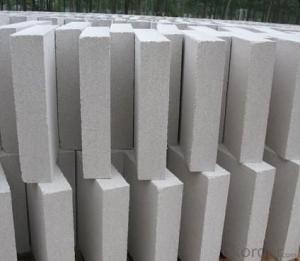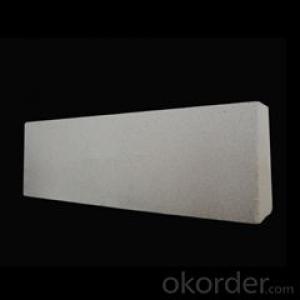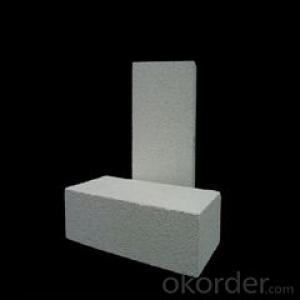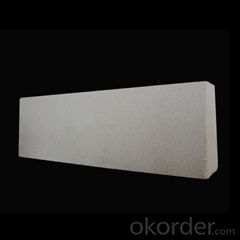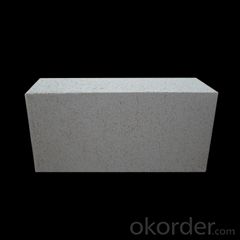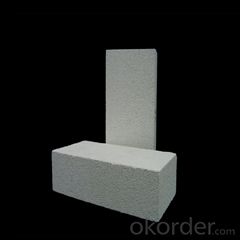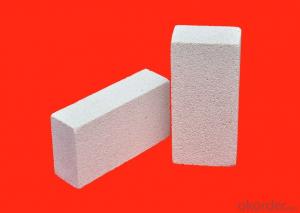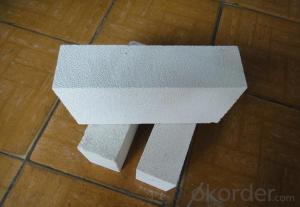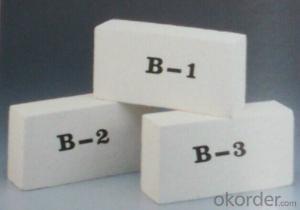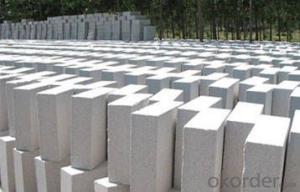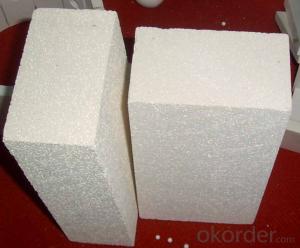Insulating Fire Brick - Refractory Mullite Insulating Refractory Brick JM 94
- Loading Port:
- Shanghai
- Payment Terms:
- TT OR LC
- Min Order Qty:
- 5000 kg
- Supply Capability:
- 10000 kg/month
OKorder Service Pledge
OKorder Financial Service
You Might Also Like
Refractory mullite insulating refractory brick JM 23
Okorder series heat insulation brick
Okorder series thermal insulation brick is an effective, energy saving, low carbon, environmental protection advanced, according to the ASTM standard manufacturing products. Okorder series products are best Li Ning and insulation in all types of industrial furnaces in the metallurgical field, aluminum, petrochemical, electric power and glass ceramic materials. They can be used as part of the working layer of thermal insulation or non - melting. Products have been widely used in the following furnace, achieved satisfactory results.
Application of heat preservation brick
Metallurgical Industry: blast furnace, hot blast furnace, heating furnace, etc..
Petrochemical Industry: ethylene cracking furnace, hydrogen production furnace, primary reformer, heating furnace, etc..
Ceramic industry: roller kiln, kiln, etc..
Glass industry: glass furnace regenerator, etc.
Carbon industry: carbon furnace, etc..
Aluminum electrolysis industry: aluminum reduction cell, etc.
Other industries: tunnel kiln, shuttle kiln, etc..
Advantages of heat insulation brick
Low thermal conductivity: more porosity will bring good thermal insulation effect, energy saving.
High crushing strength: high crushing strength, volume stability.
Low heat storage: small heat storage to absorb more heat, energy-saving effect is obvious.
Gao Chundu: iron, alkali metal impurity content is low.
The precise size: Brick size processing precision, special shape cutting and grinding, accelerate the brickwork.
Insulating brick picture
Common problem solutions
1. What products do you have?
We have all kinds of refractory bricks, refractory casting materials, mortar, cement, ceramic fiber products, etc..
Or you can browse our products to choose what you need.
2. How to control product quality?
With strict quality control system throughout the material selection and production process, we have the quality of refractory materials and ceramic fiber products to meet customer requirements.
From the selection of raw materials, the quality of our control to start. The quality certificate of the raw material is required, each batch of the products are to be tested in the use of the forward line. In the production process, the quality control by the workers, and then each piece of classification, and through the quality supervision and inspection.
3. Can you give me a brief introduction to the application of your product?
My company is mainly engaged in refractories in the steel, cement, glass, ceramics, petrochemical, electric power and other industries.
4. What information do you need if I need you?
In order to select the right products, we will provide us with information, such as the United States, technical data, order quantity, product application, etc..
If you have any questions, please contact us.

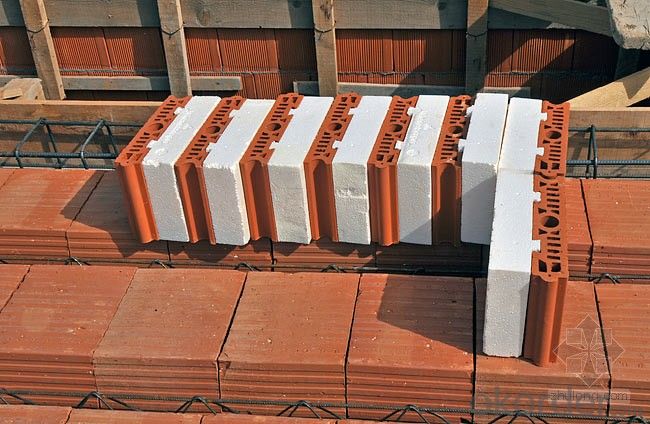
- Q: Is it necessary to use mortar when installing insulating fire bricks?
- Using mortar during the installation of insulating fire bricks is necessary. It plays a crucial role in bonding the bricks together, guaranteeing a tight and secure fit. Moreover, it contributes to the creation of a sturdy and long-lasting structure capable of enduring high temperatures. Should mortar be absent, the bricks might not be adequately secured and could shift or loosen, thereby compromising the integrity of the installation. Additionally, mortar serves to fill any gaps or spaces between the bricks, providing insulation and preventing heat loss. Consequently, employing mortar is indispensable for a prosperous and efficient installation of insulating fire bricks.
- Q: Are insulating fire bricks resistant to moisture or water damage?
- Insulating fire bricks possess a general resistance to moisture and water damage. Their low porosity and high density prevent water absorption. Moreover, they are usually crafted from materials like alumina or silica, which inherently resist moisture. Nevertheless, it must be emphasized that no material is entirely impervious to water, and continuous exposure to moisture can gradually impact the insulating fire bricks. Thus, it is advisable to take essential measures, such as applying suitable sealants or coatings, to heighten their resistance to moisture or water damage in specific scenarios.
- Q: Can insulating fire bricks be used as a backup insulation in refractory linings?
- Yes, insulating fire bricks can be used as a backup insulation in refractory linings. Insulating fire bricks are designed to have low thermal conductivity, which makes them effective in reducing heat transfer in high-temperature applications. Their insulating properties make them ideal for use as a backup insulation layer in refractory linings, helping to further reduce heat loss and improve overall energy efficiency. Additionally, insulating fire bricks are lightweight, which makes them easier to handle and install compared to other refractory materials. However, it is important to consider the specific requirements of the application and consult with a refractory engineer to ensure that insulating fire bricks are suitable for the specific conditions and performance requirements of the refractory lining.
- Q: What are the new types of building brick materials?
- The whole material made of brick and mortar is one of the most widely used building materials. According to whether the masonry is reinforced, it is divided into unreinforced brick masonry and reinforced brick masonry.
- Q: Can insulating fire bricks be used for insulation in steam boilers?
- Yes, insulating fire bricks can be used for insulation in steam boilers. These bricks are specifically designed to withstand high temperatures and provide excellent thermal insulation properties. They help to reduce heat loss and improve the overall energy efficiency of the steam boiler system.
- Q: Can insulating fire bricks be used in refractory mortar?
- Yes, insulating fire bricks can indeed be used in refractory mortar. Insulating fire bricks are lightweight and have low thermal conductivity, which makes them ideal for applications where heat insulation is required, such as in kilns, furnaces, and other high-temperature environments. Refractory mortar, on the other hand, is specifically designed to withstand high temperatures and provide a strong bond between fire bricks or other refractory materials. By using insulating fire bricks in refractory mortar, you can achieve both heat insulation and structural integrity in your application.
- Q: Can insulating fire bricks be used in refractory linings for blast furnaces?
- Yes, refractory linings for blast furnaces can utilize insulating fire bricks. These bricks are specifically designed to possess low thermal conductivity, effectively minimizing heat loss from the furnace. This characteristic holds particular significance in blast furnaces where maintaining high temperatures is crucial for optimal operation. Insulating fire bricks are crafted from lightweight refractory materials like alumina or silica, renowned for their exceptional insulating properties. These bricks not only provide thermal insulation, but they also exhibit remarkable resistance to thermal shock, rendering them suitable for the extreme conditions prevalent in blast furnaces. Beyond insulation, insulating fire bricks present additional advantages for blast furnace linings. They possess a lightweight nature and are easily installable, thereby reducing construction labor and time requirements. Moreover, their low thermal conductivity aids in minimizing the occurrence of hot spots and uneven temperature distribution within the furnace. These issues, if unaddressed, can trigger premature wear and failure of the refractory lining. However, it is crucial to acknowledge that relying solely on insulating fire bricks may not suffice for all portions of the blast furnace lining. Certain areas, such as the hearth and tuyere zones, may necessitate high-density refractory bricks capable of withstanding intense heat and mechanical stress. In such cases, a combination of insulating fire bricks and other refractory materials can be employed to achieve the desired performance and longevity. Overall, insulating fire bricks serve as a valuable constituent in refractory linings for blast furnaces, offering benefits such as enhanced energy efficiency, reduced heat loss, and prolonged lifespan of the lining.
- Q: Are insulating fire bricks suitable for use in lime kilns?
- Yes, insulating fire bricks are suitable for use in lime kilns. They have high insulating properties that help to maintain high temperatures inside the kiln while minimizing heat loss. This is important for efficient lime production. Additionally, insulating fire bricks are resistant to the corrosive nature of lime, making them a durable and reliable choice for lime kilns.
- Q: Can insulating fire bricks be used in pizza ovens or outdoor grills?
- Yes, insulating fire bricks can definitely be used in pizza ovens or outdoor grills. These bricks are designed to withstand high temperatures and provide excellent insulation, making them ideal for use in applications that require intense heat, such as pizza ovens or grills. By using insulating fire bricks, you can ensure that the heat is evenly distributed and retained within the cooking area, resulting in a more efficient cooking process and better-tasting food. Additionally, these bricks are durable and resistant to thermal shock, meaning they can withstand repeated exposure to extreme temperatures without cracking or deteriorating. Therefore, using insulating fire bricks in pizza ovens or outdoor grills is a great choice for achieving optimal heat retention and cooking performance.
- Q: Can insulating fire bricks be used in refractory cement?
- Yes, insulating fire bricks can be used in refractory cement. Insulating fire bricks are specifically designed to withstand high temperatures and provide excellent insulation, while refractory cement is used to bind and seal refractory materials. By using insulating fire bricks in refractory cement, it can enhance the overall insulation properties and improve the performance of the cement in high-temperature applications.
Send your message to us
Insulating Fire Brick - Refractory Mullite Insulating Refractory Brick JM 94
- Loading Port:
- Shanghai
- Payment Terms:
- TT OR LC
- Min Order Qty:
- 5000 kg
- Supply Capability:
- 10000 kg/month
OKorder Service Pledge
OKorder Financial Service
Similar products
Hot products
Hot Searches
Related keywords
